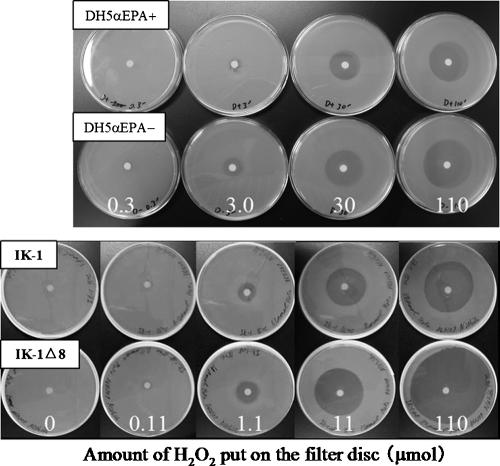FIG. 1.
Growth inhibition caused by hydrogen peroxide (H2O2) in E. coli DH5α strains with or without EPA (upper panel) and in EPA-producing S. marinintestina IK-1 and its EPA-deficient mutant IK-1Δ8 (lower panel). To perform growth inhibition tests in petri dishes, 200-μl aliquots of bacterial cultures reaching an optical density at 600 nm of 1.0 were mixed with 10 ml of LB medium containing 0.7% (wt/vol) agar, 50 μg of ampicillin/ml, and 50 μg of chloramphenicol/ml for E. coli recombinants and with 10 ml of LB medium containing 0.5 M NaCl but no antibiotics for S. marinintestina strains, and then the mixtures were layered onto LB plates containing 1.5% (wt/vol) agar and the same components, with a filter paper disc (5 mm in diameter) placed in the center. Ten-microliter aliquots of solutions containing various amounts of H2O2 (0.3 to 110 μmol for E. coli DH5α strains and 0 to 110 μmol for S. marinintestina strains) were put on the filter disc. Plates were then incubated at 20°C for 2 days and at 15°C for 3 days for E. coli DH5α strains and S. marinintestina strains, respectively. Narrower areas of growth inhibition caused by H2O2 were clearly observed for cells with EPA than for those without EPA, showing that cellular production of EPA could relieve the H2O2-induced growth inhibition of bacterial cells. (See references 34 and 35 for details.)

